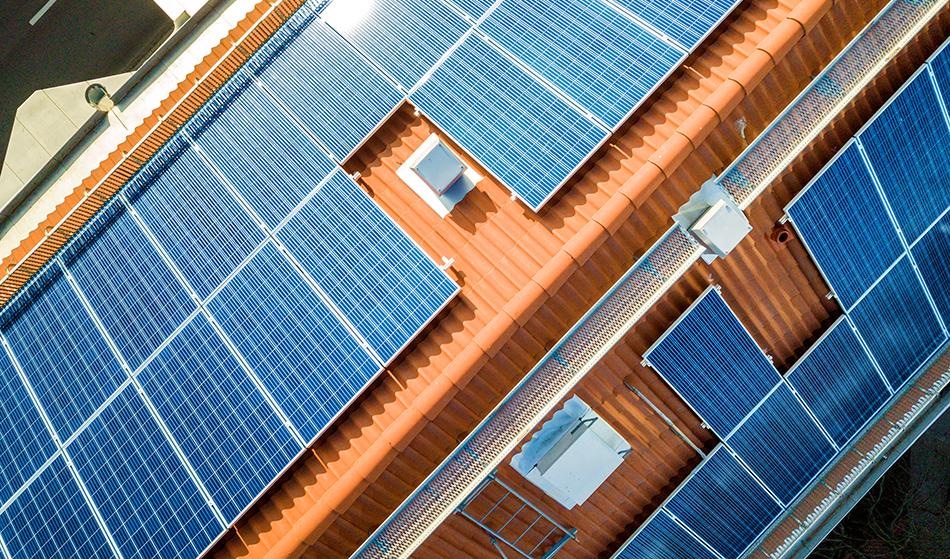
Bilanol / Shutterstock
Photovoltaic (PV) technology converts solar energy (photons) into usable electric power (electrons), usually through chemical processes in PV cells. Traditionally, PV has been applied in standalone solar panels, however recent advances in the field have enabled this renewable energy source to be harnessed within construction materials themselves.
This new generation of building-integrated photovoltaics (BIPV) replaces building envelope materials like decorative metals, tiles or even grass with an energy-generating product. Many buildings have been retrofitted with BIPV (this practice is sometimes referred to as building-applied photovoltaics, BAPV), and new buildings are increasingly designed with solar energy integration from the offset.
This is resulting in large and even domestic projects which require no power from national electric grids (produced mostly through the burning of fossil fuels, which releases carbon dioxide into the atmosphere and in turn contributes to global warming, ocean acidification and a host of other environmental problems), and in some cases are even able to provide renewable energy back to the grid.
In addition to the environmental motivation for installing BIPV, developers are financially incentivized to use the technology. Not only can building managers achieve large reductions in energy costs over the building’s lifecycle, even in some cases generating income by selling unused energy back to national grids, but also there are various government subsidy programs in place around the world to encourage the industry to take up this technology.
Available Forms of BIPV
BIPV can make up nearly all of a building’s envelope, or exterior surface.
- Flat-roof BIPV generally uses thin-film solar cell technology to add PV to a flat roof.
- Pitched-roof BIPV has incorporated advanced materials to include, for example, ceramic solar roof tiles and solar shingles in traditional pitched-roof architecture. Some of these examples even appear the same as traditional roofing materials due to the use of ceramics.
- BIPV in building facades replaces traditional cladding materials used in large commercial buildings with PV panels. This is a popular form of BAPV, as cladding the exterior of the building in this way improves and updates its appearance, increasing the resale value as well as generating power.
- PV windows can even be produced now, using semi-transparent or fully transparent PV modules. As well as generating electricity, these also have increased thermal insulation and solar radiation control properties, helping reduce energy need further within the PV-integrated building.
BIPV Applications
Due to the financial and environmental incentives, improved aesthetics, and community relationships with environmentally-concerned neighbors, partners, occupants and investors, buildings around the world have incorporated BIPV.
CIS Tower, Manchester (UK)
The CIS Tower office building is a historically significant building that residents of Manchester, UK, have been proud of for almost 60 years. Celebrating the cooperative movement which began in the northern UK city, the CIS Tower was the tallest in the country when it was first built. In 2004, the iconic building was retrofitted with PV cladding, at that time the largest PV facade in Europe. The project cost £5.5m and began returning energy to the electric grid in 2005.
Apple, Inc. Headquarters, Silicon Valley (USA)
Apple, Inc., the global technology giant, constructed its 79,000 sq m campus headquarters in Silicon Valley, USA, in 1993. The building incorporates solar panels on every surface of its roof.
mNACTEC, Barcelona (Spain)
The National Museum of Science and Industry of Catalonia, designed in 1909 as a factory, was fitted with a PV wall which generates solar power for the building and electric grid.
Patriot Place Complex, Massachusetts (USA)
Next to the New England Patriots’ famous Gillette Stadium in Foxborough, Massachusetts, the Patriot Place Complex commercial park can offer renewable energy to its occupants through the installation of PV on its flat roof. The installation was no-penetration and won the 2009 Energy Project Award.
Disclaimer: The views expressed here are those of the author expressed in their private capacity and do not necessarily represent the views of AZoM.com Limited T/A AZoNetwork the owner and operator of this website. This disclaimer forms part of the Terms and conditions of use of this website.